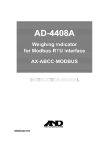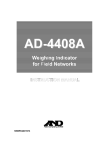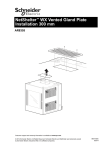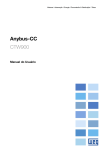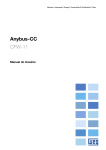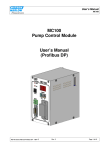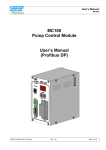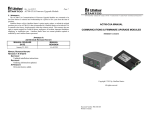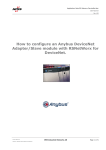Download A&D AD-4408A Instruction manual
Transcript
AD-4408A Weighing Indicator for PROFIBUS Interface AX-ABCC-PROFI INSTRUCTION MANUAL 1WMPD4001974 WARNING DEFINITIONS The warnings described in this manual have the following meanings: A potentially hazardous situation which, if not avoided, could result in death or serious injury. A potentially hazardous situation which, if not avoided, may result in minor or moderate injury or damage to the instrument. This symbol indicates caution against electrical shock. Do not touch the part where the symbol is placed. This symbol indicates the ground terminal. This symbol indicates that an operation is prohibited. NOTE Information or cautions to use the device correctly. © 2009 A&D Company, Limited. All rights reserved. No part of this publication may be reproduced, transmitted, transcribed, or translated into any language in any form by any means without the written permission of A&D Company, Limited. The contents of this manual and the specifications of the instrument covered by this manual are subject to change for improvement without notice. PROFIBUS is a registered trademark of PROFIBUS International. Anybus-CompactCom is a registered trademark of HMS Industrial Networks. TORX is a registered trademark of Textron Inc. Contents 1. About This Manual ...........................................................................................................2 2. Introduction...................................................................................................................2 3. Description of Each Part ...............................................................................................3 3.1. Status LEDs ........................................................................................................3 3.2. Communication Connector..................................................................................4 4. Installation ....................................................................................................................5 4.1. Interface Module Installation ...............................................................................5 4.2. Network Configuration.........................................................................................6 4.3. Setting the Functions ..........................................................................................6 5. PLC Memory.................................................................................................................8 5.1. Address Map .......................................................................................................8 5.1.1. OUT Data (6 words), PLC → AD-4408A .........................................................8 5.1.2. IN Data (10 words), AD-4408A → PLC .........................................................10 5.2. Handling Bits Directly ........................................................................................13 5.2.1. Handling Command Bits ...............................................................................13 5.2.2. Command bit execution procedure ...............................................................13 5.3. Operation by Commands ..................................................................................14 5.3.1. Handling Commands.....................................................................................14 5.3.2. Command execution procedure ....................................................................14 5.4. Commands........................................................................................................15 6. Timing Chart ...............................................................................................................16 6.1. Read Command ................................................................................................16 6.2. Write Command ................................................................................................16 7. Errors..........................................................................................................................18 7.1. Error Types .......................................................................................................18 8. Check Mode ...............................................................................................................19 8.1. Checking the PROFIBUS Communication Status .............................................19 8.1.1. Entering the Check Mode..............................................................................19 8.1.2. Checking the Communication Status ............................................................20 1 1. About This Manual This manual is intended for those who have a sufficient knowledge about weighing instruments and PROFIBUS. For general information regarding PROFIBUS, specifications, wiring, installation and operation, refer to PROFIBUS-related technical books. For information on PROFIBUS or PROFIBUS products, contact your local PROFIBUS Organization or PROFIBUS distributor. When configuring a network, use cables and connectors designed for PROFIBUS products. When configuring PROFIBUS, a GSD file with device information specific to the slave device is required. The GSD file is available on our website. Download it as necessary. 2. Introduction The AD-4408A functions as a slave device of PROFIBUS when the PROFIBUS interface module (AX-ABCC-PROFI) is installed. Using this interface, a PLC can control the AD-4408A and read the indicated values from the AD-4408A. Two methods of controling the AD-4408A by the PLC memory are available; handling bits directly and using commands. NOTE: The PROFIBUS interface module, when installed into the AD-4408A, uses 12 bytes (OUT) and 20 bytes (IN) of the PLC memory. So, use much care when assigning areas, not to overlap with other slave devices. Except during weighing or when weighing is possible, all of the IN data should be zero. Memory map and check modes vary with the interface module installed. This manual describes performances when the PROFIBUS interface module is installed. When other modules are installed, refer to the relevant instruction manual. Instruction manuals for each interface module are available on our website. 2 3. Description of Each Part NOTE 2 Communication connector Ground Locking catch Locking catch Status LED NOTE 1 Retaining screw Operation mode LED Fig.1 Interface module part names NOTE: 1. A TORX® driver (size T9) to fasten the retaining screws is not provided with the interface module. 2. A connector for the cable side (D-Sub 9-pin male) is not provided with the interface module. 3.1. Status LEDs NOTE: The illustration below shows how the interface module is positioned when installed to the AD-4408A. 6 Status LED 9 1 5 Operation mode LED Fig.2 Position of status LEDs Table 1 LED state Description Not initialized / No power Normal Diagnostic event in progress Recoverable error OFF Green ON Green, flashing Red ON Table 2 LED state OFF Green ON Green, flashing Red, single flash Red, double flash Status LED (ST) Operation mode LED (OP) Description Offline / No power Online (Normal) Online (Clear) Paremeter setting error PROFIBUS configuration error 3 3.2. Communication Connector NOTE: The illustration below shows how the interface module is positioned when installed to the AD-4408A. 6 9 Communication connector 1 5 Fig.3 Connector pin assignment Functions for each pin are as follows. Table 3 Communication connector Pin No. Signal Description 1 __ __ 2 __ __ 3 B (+) B line (Positive side) 4 RTS RTS 5 GND Power (GND side) 6 +5V Power (+5V side) 7 __ 8 A (-) 9 __ Housing SHIELD __ A line (Negative side) __ Shield (Connected to the AD-4408A FG terminal) 4 4. Installation 4.1. Interface Module Installation Be sure to disconnect the AD-4408A from the power source before installing the interface module. Install the interface module as follows: Blank panel Step 1 Using a Phillips screwdriver, loosen the screws that secure the blank panel to the AD-4408A rear panel, and remove the blank panel. Step 1 Step 2 Step 2 Insert the interface module into the option slot as shown to the right. Step 3 Insert the interface module until it mates with the terminals of the PC board connector located in the option slot. Option slot Retaining screw Interface module PC board in the option slot Step 4 Using a TORX® driver (size T9), fasten the retaining screws with a tightening torque of 0.25 Nm in the clockwise direction to secure the interface module. Step 3 Tightening torque 0.25 Nm Step 4 Fig.4 Interface module installation NOTE: A TORX® driver is not provided with the interface module. 5 4.2. Network Configuration Turn ON the terminators at both ends of the network. Table 4 Baud rate and distance Baud rate Single line length of cable type A 9.6 kbps 1200 m or less 19.2 kbps 1200 m or less 45.45 kbps 1200 m or less 93.75 kbps 1200 m or less 187.5 kbps 1000 m or less 500 kbps 400 m or less 1.5 Mbps 200 m or less 3 Mbps 100 m or less 6 Mbps 100 m or less 12 Mbps 100 m or less NOTE: Baud rate is set to the master baud rate automatically When configuring a network, use cables and connectors designed for PROFIBUS products. Table 5 4.3. Example manufacturer of cables and connectors PROFIBUS cables Siemens Energy and Automation, Inc. PROFIBUS connectors Siemens Energy and Automation, Inc. Setting the Functions The functions described here are general functions. General functions are divided into groups per function and are indicated by the group name followed with the function number, FXX. NOTE: General functions determine the AD-4408A performance and all of the settings are stored in the FRAM. Setting Procedure Step 1 While pressing and holding the ENTER key, press the F key. fnc is displayed to indicate that the indicator will enter the general function mode. Step 2 Press the ENTER key. The indicator enters the general function mode. To go back to the weighing mode without entering the general function mode, press the ESC key. 6 Step 3 Press the ∧ or ∨ key to select the function group to be set. Display Group name PROFIBUS-related functions pf f Press the ENTER key. The function number will be displayed. Function No. Function Description Default value pf f01 Station No. 0 to 125: Station No. 3 Step 4 Press the ∧ or ∨ key to select the function number to be set. Press the ENTER key. The current setting value will be displayed. Step 5 Change the setting value using either one of the methods below. Method Selecting a parameter Inputting the value Description Only the parameter number to be selected is displayed and blinks. Press the ∧ or ∨ key to select a parameter. All the digits are displayed and a digit to be changed blinks. Press the < or > key to select a digit and press the ∧ or ∨ key to change the value. After setting, press the ENTER key. The next function number is displayed. When the parameter is not to be changed, press the ESC key to return to the function number display. Step 6 Press the ESC key. The function number disappears and the indicator returns to the state of step 3. Press the ESC key to store the setting values in the FRAM and go back to the weighing mode. NOTE: The blinking decimal point indicates that the current value is not the weight value. If a value exceeding the settable range is entered, err dt is displayed and the input is canceled. 7 5. PLC Memory 5.1. Address Map Commands to operate the AD-4408A and operating parameters are written into the PLC memory OUT data (6 words) and are executed. Response data from the AD-4408A is read to the PLC memory IN data (10 words). Data used such as Write data is in hexadecimal format. NOTE: The PROFIBUS interface module, when installed into the AD-4408A, uses 12 bytes (OUT) and 20 bytes (IN) of the PLC memory. So, use much care when assigning areas, not to overlap with other slave devices. 5.1.1. OUT Data (6 words), PLC → AD-4408A Bit 15 14 13 12 First word of OUT data 9 8 7 6 5 4 3 2 1 0 3 2 1 0 Write data (Low order word) Bit Second word of OUT data 11 10 15 14 13 12 11 10 9 8 7 6 5 4 Write data (High order word) Zero Clear the zero value Tare Clear the tare value Hold* Net display Gross display Manual print command Bits 8-15 are internally reserved. Bit 15 14 13 12 11 10 Third word of OUT data 9 8 7 6 5 4 Command bits *Hold at the rising edge, release at the falling edge 8 3 2 1 0 Bit 15 14 13 12 11 10 Fourth word of OUT data 9 8 7 6 5 4 3 2 1 0 5 4 3 2 1 0 Reserved internally Bit 15 14 13 12 11 10 Fifth word of OUT data 9 8 7 6 Command No. Bits 3-15 are internally reserved. Bit 15 14 13 12 11 10 Sixth word of OUT data R / W flag Command request flag Error reset flag 9 8 7 6 5 4 Command bits About OUT Data Write data ----------------------Used by the write command. Command bits-----------------Assigns a function to execute to each bit. Command No.-----------------Specifies a command number to execute. R / W flag-----------------------Specifies a command type, read or write. Internally reserved -----------Do not write anything other than 0 (zero). 9 3 2 1 0 5.1.2. IN Data (10 words), AD-4408A → PLC Bit First word of IN data 15 14 13 12 9 8 7 6 5 4 3 2 1 0 3 2 1 0 3 2 1 0 3 2 1 0 3 2 1 0 3 2 1 0 Net weight Weight value (Low order word) Bit Second word of IN data Bit Third word of IN data Bit Fourth word of IN data Bit 15 14 13 12 11 10 9 8 7 6 5 4 Net weight Weight value (High order word) 15 14 13 12 11 10 9 8 7 6 5 4 Gross weight Weight value (Low order word) 15 14 13 12 11 10 9 8 7 6 5 4 Gross weight Weight value (High order word) 15 14 13 12 Fifth word of IN data 11 10 9 8 7 6 5 4 Read data (Low order word) Bit Sixth word of IN data 11 10 15 14 13 12 11 10 9 8 7 6 5 4 Read data (High order word) Stable Net center of zero Gross center of zero Net display Gross display Tare in progress Hold in progress Capacity exceeded Weighing failure In sync with Bits 10-15 are internally reserved. Bit 15 14 13 12 11 10 Seventh word of IN data 9 8 7 Status bits 10 6 5 4 3 2 1 0 Net over Net under Gross over Gross under Input (A/D) over Input (A/D) under Zero error Tare error Net display error Bits 9-15 are internally reserved. Bit 15 14 13 12 11 10 9 Eighth word of IN data 7 6 5 4 3 2 1 0 6 5 4 3 2 1 0 1 0 Status bits Bit 15 14 13 12 11 10 Ninth word of IN data 8 9 8 7 Command No. response R / W response flag Command request response flag Slave normal operation Slave ready Error status flag Decimal point position 20 Decimal point position 21 Decimal point position 22 Unit 20 Unit 21 Unit 22 Checksum error Input (A/D) error FRAM error Calibration error Mode error Bit 15 14 13 12 11 10 Tenth word of IN data 9 8 7 Status bits 11 6 5 4 3 2 Unit Decimal point position 0: None 1: g 2: kg 3: t 4: lb (USA version) 0: None 1: 101 2: 102 3: 103 4: 104 5: 105 123456 12345.6 1234.56 123.456 12.3456 1.23456 About IN Data Slave ready --------------------Bit to turn ON when the AD-4408A is in the weighing mode. Command No. response ---Response data to a command number. Read data ----------------------Response data to a command. R / W response flag----------Response to the OUT data R / W flag. Reserved internally ----------Not used. Status area --------------------The weighing status of the AD-4408A is output. NOTE: For further information, refer to “5.3. Operation by Commands”. 12 5.2. Handling Bits Directly 5.2.1. Handling Command Bits A command bit is in the third word of OUT data. To execute, turn the corresponding command bit ON. The command bit will be effective at the rising edge. The signal level must be maintained for 30 msec minimum. Table 7 Third word of OUT data Command bits Bit 0 Bit 1 Bit 2 Bit 3 Bit 4 Bit 5 Bit 6 Bit 7 Command bit and action Zero Clear the zero value Tare Clear the tare value Hold Net display Gross display Manual print command 5.2.2. Command bit execution procedure Step 1 Turn OFF all the PLC memory command bits. Step 2 Turn ON the PLC memory command bit to be executed. Step 3 The AD-4408A executes the command. Step 4 Turn OFF all the PLC memory command bits. 13 5.3. Operation by Commands 5.3.1. Handling Commands Specify the R / W flag either to the read command or the write command. R / W flag: 0: Write command 1: Read command Specify a command to execute to the command No. Specify the command data to be written to Write data. The command will be effective at the rising edge of the command request flag. The signal level must be maintained for 30 msec minimum. The response result to the command request is output as the command request response flag. The command response result is output as the command No. response. The response result of the read command is output as the read data. 5.3.2. Command execution procedure Before execution Step 1 Confirm that the command request flag is turned OFF. Step 2 Specify the R / W flag either to the read command or the write command. R / W flag: 0: Write command 1: Read command Step 3 Specify the command to execute to the command No. Step 4 Specify the command data to be written to Write data when necessary. Execution Step 5 Confirm that the slave ready bit is turned ON. Step 6 Turn the command request flag ON. The command will be executed at the rising edge. Step 7 The AD-4408A responses. The response results are output as the command request response flag, R / W response flag and command No. response. Step 8 When the read command is specified by the R / W flag, a response will be output as the read data. After execution Step 9 Turn the command request flag OFF. 14 5.4. Commands The master device uses the write command to convey instructions to the AD-4408A. For details, refer to “6.2. Write Command” of “6. Timing Chart”. Table 7 Commands Command No. 0 0 0 0 0 0 0 0 Command data 1 2 3 4 5 6 7 8 Command Zero Clear the zero value Tare Clear the tare value Hold Net display Gross display Manual print command 15 6. Timing Chart 6.1. Read Command Specify the data type to read to the command No. The read data is output to the read data area. R / W flag is ON. R / W flag Command No. Command request flag R / W response flag Command No. response Read data Command request response flag Fig.5 6.2. Read command Write Command Write Command Specify the data type to write to the command No. Place the data to be written to Write data. R / W flag is OFF. R / W flag Command No. Write data Command request flag R / W response flag Command No. response Command request response flag Fig.6 16 Write command Slave Normal Operation Slave normal operation is a signal to confirm that the AD-4408A is connected to the power and is in normal operating conditions. During normal operation, the signal is reversed at a 0.5 to 1 second interval. Slave normal operation 0.5 to 1 sec Fig.7 Slave normal operation signal Error status flag If an AD-4408A error has occurred, the slave ready bit will be turned OFF and the error status flag will be turned ON to convey to the master device that an error has occurred. The master device will turn the error reset flag ON to request resetting the error status flag. Error status flag Error reset flag Slave ready Fig.8 Table 8 Command bits / Status bits Memory Sixth word of OUT data Tenth word of IN data Resetting the error status flag Description Bit 2 Error reset flag Bit 2 Slave normal operation Bit 3 Slave ready Bit 4 Error status flag 17 7. Errors 7.1. Error Types Error Status Flag This conveys to the master device that an error has occurred. Turn the error reset flag ON to request resetting the error status flag. Table 9 Error status flag Error type Causes Checksum error Program checksum does not match. Input (A/D) error Data can not be acquired from the A/D converter. FRAM error Data can not be written into the FRAM. Calibration error Calibration data is not correct. Mode error Moved to a mode other than the weighing mode. Weighing Failure This conveys a weighing failure to the master device. This will be reset when normal weighing has resumed. Table 10 Weighing failure Error type Causes Zero error Zero adjustment is not performed. Tare error Tare is not performed. Net display error A net value is not displayed. Capacity exceeded The weighing capacity has been exceeded. Capacity Exceeded This conveys to the master device that the weighing capacity has been exceeded. This will be reset when all the errors are cleared. Table 11 Capacity exceeded Error type Causes Net over The net weight is over the net weight range. Net under The net weight is below the net weight range. Gross over The gross weight is over the gross weight range. Gross under The gross weight is below the gross weight range. A/D over A/D value is over the A/D value range. A/D under A/D value is below the A/D value range. 18 8. Check Mode 8.1. Checking the PROFIBUS Communication Status 8.1.1. Entering the Check Mode Step 1 While pressing and holding the ENTER key, press the F key. fnc is displayed to indicate that the indicator will enter the general function mode. To go back to the weighing mode, press the ESC key. Step 2 While pressing and holding the ZERO key, press the ENTER key. 1Chc is displayed to indicate that the indicator will enter the check mode. Press the ENTER key again to display an item to be checked. Step 3 Press the ∧ or ∨ key to select Chc pf (PROFIBUS check mode) and press the ENTER key to enter the PROFIBUS check mode. To exit from the check mode, press the ESC key. Table 12 Check mode list Display Chckey Chc Cl Chc∗∗∗ Chc pf Chc∗∗∗ Chc r5 Chc ad Chc in Chcpr9 Chc 5n C5 pr9 C5 fra Calfdt Checking item Key switches Standard serial output Interfaces PROFIBUS Testing terminal A/D (Load cell) Internal count Program version Serial number Program checksum Memory (FRAM) checksum Calibration-related functions 19 8.1.2. Checking the Communication Status Press the ∧ or ∨ key to change addresses. Two digits: address (01 to 06, 11 to 1A) Four digits: data (0000 to FFFF) 8 8.8 8 8 8 □ □ □ □ □ □ Slave error Slave ready ブ デ Slave normal operation Interface error Interface wait Interface active Address Data type Word 01 to 06 OUT data 1 to 6 11 to 1A IN data 1 to 10 20






















